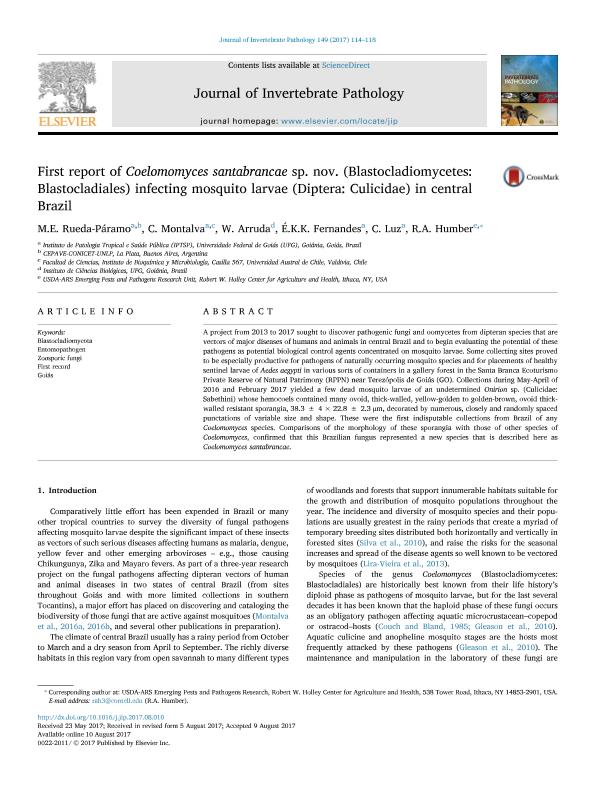Mostrar el registro sencillo del ítem
dc.contributor.author
Rueda Páramo, Manuel Enrique

dc.contributor.author
Montalva, C.
dc.contributor.author
Arruda, W.
dc.contributor.author
Fernandes, Éverton

dc.contributor.author
Luz, Wolf Christian

dc.contributor.author
Humber, Richard A.

dc.date.available
2018-06-25T17:03:00Z
dc.date.issued
2017-10
dc.identifier.citation
Rueda Páramo, Manuel Enrique; Montalva, C.; Arruda, W.; Fernandes, Éverton; Luz, Wolf Christian; et al.; First report of Coelomomyces santabrancae sp. nov. (Blastocladiomycetes: Blastocladiales) infecting mosquito larvae (Diptera: Culicidae) in central Brazil; Academic Press Inc Elsevier Science; Journal of Invertebrate Pathology; 149; 10-2017; 114-118
dc.identifier.issn
0022-2011
dc.identifier.uri
http://hdl.handle.net/11336/49943
dc.description.abstract
A project from 2013 to 2017 sought to discover pathogenic fungi and oomycetes from dipteran species that are vectors of major diseases of humans and animals in central Brazil and to begin evaluating the potential of these pathogens as potential biological control agents concentrated on mosquito larvae. Some collecting sites proved to be especially productive for pathogens of naturally occurring mosquito species and for placements of healthy sentinel larvae of Aedes aegypti in various sorts of containers in a gallery forest in the Santa Branca Ecoturismo Private Reserve of Natural Patrimony (RPPN) near Terezópolis de Goiás (GO). Collections during May-April of 2016 and February 2017 yielded a few dead mosquito larvae of an undetermined Onirion sp. (Culicidae: Sabethini) whose hemocoels contained many ovoid, thick-walled, yellow-golden to golden-brown, ovoid thick-walled resistant sporangia, 38.3 ± 4 × 22.8 ± 2.3 µm, decorated by numerous, closely and randomly spaced punctations of variable size and shape. These were the first indisputable collections from Brazil of any Coelomomyces species. Comparisons of the morphology of these sporangia with those of other species of Coelomomyces, confirmed that this Brazilian fungus represented a new species that is described here as Coelomomyces santabrancae.
dc.format
application/pdf
dc.language.iso
eng
dc.publisher
Academic Press Inc Elsevier Science

dc.rights
info:eu-repo/semantics/openAccess
dc.rights.uri
https://creativecommons.org/licenses/by-nc-sa/2.5/ar/
dc.subject
Blastocladiomycota
dc.subject
Entomopathogen
dc.subject
First Record
dc.subject
Goiás
dc.subject
Zoosporic Fungi
dc.subject.classification
Otras Ciencias Biológicas

dc.subject.classification
Ciencias Biológicas

dc.subject.classification
CIENCIAS NATURALES Y EXACTAS

dc.title
First report of Coelomomyces santabrancae sp. nov. (Blastocladiomycetes: Blastocladiales) infecting mosquito larvae (Diptera: Culicidae) in central Brazil
dc.type
info:eu-repo/semantics/article
dc.type
info:ar-repo/semantics/artículo
dc.type
info:eu-repo/semantics/publishedVersion
dc.date.updated
2018-06-25T16:14:29Z
dc.journal.volume
149
dc.journal.pagination
114-118
dc.journal.pais
Estados Unidos

dc.description.fil
Fil: Rueda Páramo, Manuel Enrique. Universidade Federal de Goiás; Brasil. Consejo Nacional de Investigaciones Científicas y Técnicas. Centro Científico Tecnológico Conicet - La Plata. Centro de Estudios Parasitológicos y de Vectores. Universidad Nacional de La Plata. Facultad de Ciencias Naturales y Museo. Centro de Estudios Parasitológicos y de Vectores; Argentina
dc.description.fil
Fil: Montalva, C.. Universidade Federal de Goiás; Brasil. Universidad Austral de Chile; Chile
dc.description.fil
Fil: Arruda, W.. Universidade Federal de Goias. Instituto de Ciencias Biologicas; Brasil
dc.description.fil
Fil: Fernandes, Éverton. Universidade Federal de Goiás; Brasil
dc.description.fil
Fil: Luz, Wolf Christian. Universidade Federal de Goiás; Brasil
dc.description.fil
Fil: Humber, Richard A.. United States Department of Agriculture. Agricultural Research Service; Argentina
dc.journal.title
Journal of Invertebrate Pathology

dc.relation.alternativeid
info:eu-repo/semantics/altIdentifier/doi/http://dx.doi.org/10.1016/j.jip.2017.08.010
dc.relation.alternativeid
info:eu-repo/semantics/altIdentifier/url/https://www.sciencedirect.com/science/article/pii/S0022201117302501
Archivos asociados
